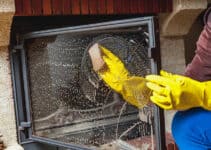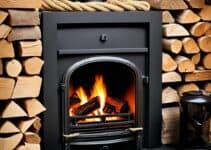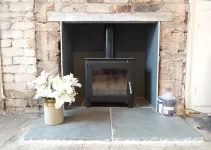As an advocate for home comfort and safety, I’m keenly aware of the rising popularity of wood-burning stoves. They provide an economical and cosy addition to any dwelling, eclipsing conventional heating methods like gas or electricity.
However, investing in a log burner stove comes with vital considerations – chiefly, ensuring that the stove body is equipped with the necessary safety features to protect your home and loved ones. In this segment, we will delve into the critical safety features that should be present in every wood stove body, from log burner stove safety features to the very design of the stove body.
Understanding wood stove safety is not just about installation, it is about making informed choices concerning the materials and features of the log burner stove itself. When I address the types of log burner stove features available, I’m not merely talking about aesthetic enhancements; I’m referring to features that safeguard against improper combustion, accidental fires, and perilous carbon monoxide leaks. These are realistic concerns for any stove owner, and are ones that can be effectively managed with professional installation and adherence to safety norms.
Join me as I guide you through the essential aspects of stove body safety – an indispensable read for anyone considering the embrace of the wood stove’s warm allure. Knowledge is the best defence against the risks associated with wood stoves, and I intend to arm you with all you need to know for a secure and pleasurable experience with your log burner stove.
Understanding Wood Stove Safety and Installation Standards
When it comes to ensuring the safety and efficiency of log burner stoves, I recognise three fundamental pillars: the necessity of professional stove installation, strict adherence to clearance guidelines, and robust annual inspection and maintenance regimes. Diving into each of these crucial aspects provides homeowners with the knowledge required to maintain their stove’s integrity and prevent potential hazards.
The Importance of Professional Installation
A stove’s body design is central to its safe operation, which is why professional stove installation isn’t just recommended; it’s a must. You shouldn’t install this yourself.
Certifications, akin to those provided by The National Fireplace Institute in the United States, signify an installer’s competency not only with the technical aspects of setting up a wood stove but also their adherence to updated safety regulations. I strongly advocate engaging professionals who are equipped to assess and determine the correct size of the stove based on your specific heating requirements, crucial in preventing overfiring or underfiring. And wait some time before using it immediately after installation.
Regulations, such as those encapsulated within EPA Phase II-certified emissions standards, must be stringently followed to ensure not just the safety but also the environmental impact of log burning practices.
Adhering to Clearance Guidelines
Log burner safety design extends beyond the appliance itself to its environment. The placement of a wood stove within a living space matters immensely, as inadequate clearance from combustibles can lead to safety hazards like accidental fires. After the professional installation of my stove, I endorse completing a thorough safety check that includes confirming sufficient clearance from all combustible materials. Additionally, constructing specialised heat shields and ensuring adequate support for the stove’s weight is essential, especially in historical properties where the chimney structure may have weakened over time.
Annual Inspection and Maintenance Protocols
Like any well-engineered appliance, stove body safety is heavily reliant on rigorous upkeep. Committing to annual professional inspections can preempt and remedy any emerging risks, particularly in the venting systems. I find that utilising stovepipe thermometers to monitor flue temperatures contributes significantly to one’s maintenance routine, offering a clear indication of the stove’s operational status. It’s these regular checks and the ongoing maintenance that are the keystones in maintaining the safe and effective operation of the wood stove.
Comprehending these standards and protocols thoroughly is of the utmost importance for anyone seeking to incorporate a wood stove into their home. I can personally attest that diligent application of these safety practices in conjunction with a conscious approach to stove maintenance will ensure that your log burner will provide not only warmth but also peace of mind through the years.
The Role of Stove Body Materials in Ensuring Safety
When it comes to selecting a wood stove for efficient heating and safety, the choice of log burner stove body materials is paramount. My experience with various installations has shown that the materials used in the construction of the stove body drastically influence both the efficacy and safety of the wood-burning process.
Materials such as carbon steel are renowned for their longevity and ability to withstand high temperatures, which is why contemporary safety design wood stoves frequently incorporate this component. The internal structure might also include vermiculite panels that contribute to consistent heat distribution while acting as an insulator.
Moreover, a vital aspect of the material makeup is the inclusion of high-quality, heat-resistant ceramic glass from brands like Schott and NEG. This allows for a clear view of the flames while ensuring the wood stove door is sealed properly, vital for regulating combustion and preventing heat loss. A well-designed wood stove, which indulges in the elegance of such materials, ensures that the heat is not only retained within the stove but is also evenly distributed throughout the room.
To further underscore the importance of using robust materials, efficient heating wood stoves are characteristically covered in heat-resistant paint from brands such as Forest, maximizing their endurance against the intense conditions within. This coat not only enhances the wood stove’s durability but also its resistance to wear and overheating—a critical safety consideration for any stove owner.
In my consistent pursuit to bring warmth and comfort to homes with minimum environmental impact, I’ve been particularly impressed with stoves that showcase carbon-neutral materials, reflecting the industry’s commitment to sustainability. Indeed, the efficiency of wood as a combustion material is amplified when paired with a stove engineered from eco-friendly, sturdy, and safe materials.
- Carbon Steel: Fortifies the stove body and extends lifespan.
- Vermiculite Panels: Improves heat distribution while insulating.
- Ceramic Glass: Elevates safety with heat-resistant visibility.
- Heat-Resistant Paint: Shields the stove body from extreme temperatures and contributes to the aesthetic appeal.
Clearly, the materials chosen for the log burner stove body are not merely about appearance; they are integral to the safety and heating efficiency of the stove. As such, I always recommend that buyers look beyond mere design and consider the safety implications and long-term benefits of high-quality materials when choosing their ideal wood stove.
Safety Features of Log Burner Stove Body
As a proponent of embracing the rustic charm and efficiency of log burner stoves, I place paramount importance on safety. Manufacturing brands are continuously innovating to integrate safety features into their log burner stove bodies to protect users and enhance the stove’s overall performance. Some of these features are visible and tangible, while others operate behind the scenes to provide a safe, comfortable heat source.
Sealed Doors and Non-combustible Seals
One of the primary safety measures for any log burner is the inclusion of securely sealed doors, ensuring safe and efficient combustion. This design, featuring non-combustible materials such as reinforced glass and durable gaskets, acts as a barrier against accidental sparks or embers that might escape. The sealed doors also play a vital role in trapping heat within the stove body to maintain consistent temperatures and prevent hazardous gases from leaking into the living space.
Airflow Control and Combustion Management
Effective combustion management is achieved through sophisticated airflow control systems. These systems allow for precise regulation of oxygen, which is crucial for the efficient burning of logs and the reduction of smoke emissions. The presence of a reduction zone, an area within the stove where combustion gases are further broken down, signifies the advancement in stove technology that significantly lowers carbon monoxide emissions. It’s an innovation that not only refines the safety of the log burner stove body but also uplifts the air quality of your home environment.
Heat Shields and Floor Protection
Heat shields and floor protection are indispensable components in stove safety, designed to insulate and safeguard the area surrounding the stove. These elements prevent the intense heat generated by the stove from causing any damage to the nearby walls and flooring, mitigating the risk of accidental fires and ensuring peace of mind for homeowners. Below is a table highlighting the various stove body safety features and their significance.
| Safety Feature | Function | Benefits |
|---|---|---|
| Sealed Doors | Prevent escape of hot embers and gases | Enhanced safety and more efficient heating |
| Non-Combustible Materials | Resist high temperatures without igniting | Protection against fires and long-lasting durability |
| Airflow Control | Regulate oxygen intake for combustion | Optimised fuel usage and reduced emissions |
| Combustion Management | Lower hazardous gas output | Cleaner operation and better air quality |
| Heat Shields | Deflect heat away from surroundings | Prevents damage to property and improves safety |
| Floor Protection | Guard against radiating heat | Preserves flooring material and structural integrity |
Preventive Measures to Mitigate the Risks of Wood Stoves
As an avid advocate for log burner stove safety, I recognise the paramount importance of employing a series of preventive measures. These strategies are essential to maintaining a safe environment while enjoying the warm embrace of a wood stove’s heat. Let’s delve into several key practices that homeowners should adopt to ensure their wood stove use is as safe as it is satisfying.
Effective Ventilation Strategies
Proper air circulation plays a significant role in the safe operation of a log burner stove. To minimise the risk of harmful emissions, effective ventilation is critical. Adequate daily ventilation ensures that any unwanted particles and gases are dissipated. I make it a regular practice to check for any signs of obstruction or damage within the ventilation system and swiftly address any faults to uphold immaculate air quality within the home.
Creosote Accumulation and Chimney Sweeping
One cannot overstate the significance of creosote management in maintaining a safe wood stove. This hazardous by-product can accumulate in chimneys and pose a severe fire risk. Thus, regular chimney sweeping is an indispensable preventive measure that cannot be omitted. I commit to scheduling professional chimney cleaning to eradicate creosote deposits, an action that drastically reduces the likelihood of chimney fires and enhances overall safety.
The Essentials of Correct Fuel Usage
The choice of fuel is crucial for safe and efficient wood stove operation. I steadfastly advocate the use of dry, seasoned, non-resinous wood to prevent excessive smoke and creosote formation. It is also wise to forego the use of flammable liquids for ignition, thereby averting potential hazards. Through correct fuel usage, the wood stove’s performance is maximised, and the user’s safety is substantially bolstered.
- Ensure daily room ventilation
- Regularly inspect ventilation system
- Schedule professional chimney sweeps
- Utilise appropriate, high-quality firewood
- Avoid flammable liquids for fire starting
In implementing these preventive measures for wood stove usage, including effective ventilation, meticulous creosote management, and the use of correct fuels, we safeguard our homes and loved ones against potential risks. My commitment to chimney sweeping, along with careful attention to the nuances of fuel choice, forms the cornerstone of my responsible wood stove practices.
Conclusion
In synthesising the information gathered, it’s clear that the core safety features of a log burner stove body are fundamental to fostering both a secure and pleasurable ambiance within one’s dwelling. The meticulous selection and application of durable materials in stove body design not only form a bastion against the hazards associated with wood stoves but also exemplify a commitment to quality and safety. In my role as an advocate for responsible wood stove use, I’ve illuminated how simple practices, when performed correctly, can significantly elevate the safety of these charming heating units.
My analysis underlines the necessity of securing a wood stove’s installation by expertise hands, ensuring optimal functionality and compliance with prevailing safety standards. With robust log burner safety mechanisms at play—ranging from stringent clearance to effective ventilation, and intelligent use of resources—the risks that once loomed large are now substantial lessened, granting peace of mind to users. My aim is to arm readers of Village and Cottage with the knowledge to impeccably integrate these units into their homes, enhancing their living spaces with warmth while placing safety at the forefront.
Ultimately, by adhering to the principles and protective measures highlighted throughout my exploration, we usher in an era where the aesthetic and practical appeal of wood-burning stoves is matched by robust safety features. It’s my hope that this informative journey equips you, the reader, with the confidence to enjoy the serene glow of a log burner stove body, safe in the knowledge that your health and home are amply shielded by design and diligence.


